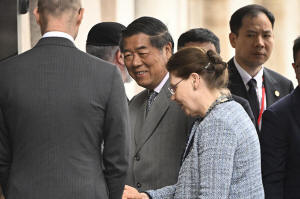US and China agree to work on extending the tariff pause deadline in
trade talks in Stockholm
[July 30, 2025] By
JAMEY KEATEN and DIDI TANG
STOCKHOLM (AP) — The United States and China have agreed to work on
extending a deadline for new tariffs on each other after two days of
trade talks in Stockholm concluded on Tuesday, according to Beijing’s
lead negotiator.
The U.S. side says the extension was discussed, but not decided.
China said the two sides had “in-depth, candid and constructive”
discussions and agreed to work on extending a pause in tariffs beyond an
Aug. 12 deadline for a trade deal for another 90 days.
“A stable, healthy and sustainable China-U.S. economic and trade
relationship serves not only the two countries’ respective development
goals but also contributes to global economic growth and stability,”
said China's Vice Premier He Lifeng, who led the Chinese side, according
to a statement from China's Ministry of Commerce. He did not say how the
extension would work.
U.S. Treasury Secretary Scott Bessent described the talks as a “very
fulsome two days with the Chinese delegation."
He said they touched on U.S. concerns over China's purchase of Iranian
oil, supplying Russia with dual-use tech that could be used on the
battlefield, and manufacturing goods at a rate beyond what is sustained
by global demand.
“We just need to de-risk with certain, strategic industries, whether
it's the rare earths, semiconductors, medicines, and we talked about
what we could do together to get into balance within the relationship,”
Bessent said.
He stressed that the U.S. seeks to restore domestic manufacturing,
secure purchase agreements of U.S. agricultural and energy products, and
reduce trade deficits.

Meeting in the Swedish capital
The latest round of talks opened Monday in Stockholm to try to break a
logjam over tariffs that have skewed the pivotal commercial ties between
the world’s two largest economies.
The two sides previously met in Geneva and London to address specific
issues — triple-digit tariffs that amounted to a trade embargo and
export controls on critical products — China's chokehold on rare earth
magnets, and U.S. restrictions on semiconductors.
Monday's discussions lasted nearly five hours behind closed doors at the
office of Swedish Prime Minister Ulf Kristersson. Before the talks
resumed Tuesday, Kristersson met with Bessent and U.S. Trade
Representative Jamieson Greer over breakfast.
A possible Trump-Xi meeting
The talks in Stockholm unfolded as President Donald Trump is mulling
plans to meet Chinese President Xi Jinping, a summit that could be a
crucial step toward locking in any major agreements between their two
countries.
“I would say before the end of the year,” Trump told reporters aboard
Air Force One on Tuesday.
On his Truth Social media platform, Trump insisted late Monday that he
was not “seeking” a summit with Xi, but may go to China at the Chinese
leader’s invitation, “which has been extended. Otherwise, no interest!”
Bessent told reporters the summit was not discussed in Stockholm but
that they did talk about “the desire of the two presidents for the trade
team and the Treasury team to have trade negotiations with our Chinese
counterparts.”
Greer said the American team would head back to Washington and “talk to
the president about” the extension of the August deadline and see
“whether that’s something that he wants to do.”

[to top of second column] |

Chinese Vice Premier He Lifeng arrives to Rosenbad ahead of the
second day of trade talks between China and the U.S., in Stockholm,
Sweden, Tuesday July 29, 2025. (Fredrik Sandberg/TT News Agency via
AP)
 Striking tariff deals
The U.S. has struck deals over tariffs with some of its key trading
partners — including Britain, Japan and the European Union — since
Trump announced earlier in July elevated tariff rates against dozens
of countries. China remains perhaps the biggest challenge.
“The Chinese have been very pragmatic,” Greer said in comments
posted on social media by his office late Monday. “We have tensions
now, but the fact that we are regularly meeting with them to address
these issues gives us a good footing for these negotiations.”
Many analysts had expected that the Stockholm talks would result in
an extension of current tariff levels, which are far lower than the
triple-digit percentage rates proposed as the U.S.-China tariff tiff
reached a crescendo in April, sending world markets into a temporary
tailspin.
The two sides backed off the brink during bilateral talks in Geneva
in May and agreed to a 90-day pause — which ends Aug. 12 — of those
sky-high levels. They currently stand at U.S. tariffs of 30% on
Chinese goods, and China’s 10% tariff on U.S. products.
The long view
While China has offered few specifics of its goals in the Stockholm
talks, Bessent has suggested that the situation has stabilized to
the point that Beijing and Washington can start looking toward
longer-term balance between their economies.
Since China vaulted into the global trading system more than two
decades ago, Washington has sought to press Beijing to encourage
more consumption at home and offer greater market access to foreign,
including American-made goods.
Wendy Cutler, a former U.S. trade negotiator and now vice president
at the Asia Society Policy Institute, said Trump’s team would today
face challenges from “a large and confident partner that is more
than willing to retaliate against U.S. interests.”
Rollover of tariff rates “should be the easy part,” she said,
warning that Beijing has learned lessons since the first Trump
administration and “will not buy into a one-sided deal this time
around.”

Goodbye Stockholm
Bessent said the “overall tone of the meetings was very
constructive" while Li said the two sides agreed in Stockholm to
keep close contact and to “communicate with each other in a timely
manner on trade and economic issues.”
On Monday, police cordoned off a security zone along Stockholm’s
vast waterfront as rubbernecking tourists and locals sought a
glimpse of the top-tier officials through a phalanx of TV news
cameras lined up behind metal barriers.
Flagpoles at the prime minister’s office were festooned with the
American and Chinese flags.
___
Tang reported from Washington. Associated Press writer Josh Boak in
Washington and Huizhong Wu in Bangkok contributed to this report.
All contents © copyright 2025 Associated Press. All rights reserved |